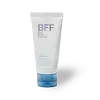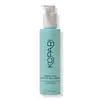What's inside
What's inside
 Key Ingredients
Key Ingredients

 Benefits
Benefits

 Concerns
Concerns

 Ingredients Side-by-side
Ingredients Side-by-side

Water
Skin ConditioningGlycerin
HumectantCoco-Betaine
CleansingDisodium Laureth Sulfosuccinate
CleansingAcrylates Copolymer
Disodium Cocoamphodiacetate
CleansingButylene Glycol
HumectantAloe Barbadensis Leaf Juice
Skin ConditioningMicrocitrus Australis Fruit Extract
Skin ConditioningCitrus Australasica Fruit Extract
AntioxidantCamellia Sinensis Leaf Extract
AntimicrobialCentella Asiatica Extract
CleansingPolygonum Cuspidatum Root Extract
AntioxidantScutellaria Baicalensis Root Extract
AstringentGlycyrrhiza Glabra Root Extract
BleachingChamomilla Recutita Extract
Skin ConditioningRosmarinus Officinalis Leaf Extract
AntimicrobialLonicera Japonica Flower Extract
Skin ConditioningPerilla Frutescens Leaf Extract
MaskingPaeonia Suffruticosa Root Extract
Skin ProtectingSalicylic Acid
MaskingPotassium Hydroxide
BufferingCitric Acid
BufferingPolyquaternium-7
Sodium Chloride
MaskingPhenoxyethanol
PreservativeDisodium EDTA
Parfum
MaskingWater, Glycerin, Coco-Betaine, Disodium Laureth Sulfosuccinate, Acrylates Copolymer, Disodium Cocoamphodiacetate, Butylene Glycol, Aloe Barbadensis Leaf Juice, Microcitrus Australis Fruit Extract, Citrus Australasica Fruit Extract, Camellia Sinensis Leaf Extract, Centella Asiatica Extract, Polygonum Cuspidatum Root Extract, Scutellaria Baicalensis Root Extract, Glycyrrhiza Glabra Root Extract, Chamomilla Recutita Extract, Rosmarinus Officinalis Leaf Extract, Lonicera Japonica Flower Extract, Perilla Frutescens Leaf Extract, Paeonia Suffruticosa Root Extract, Salicylic Acid, Potassium Hydroxide, Citric Acid, Polyquaternium-7, Sodium Chloride, Phenoxyethanol, Disodium EDTA, Parfum
Water
Skin ConditioningSodium Cocoyl Isethionate
CleansingGlycerin
HumectantDecyl Glucoside
CleansingLauramidopropyl Betaine
CleansingPotassium Cocoyl Glycinate
Acrylates Copolymer
1,2-Hexanediol
Skin ConditioningSodium Chloride
MaskingArginine
MaskingParfum
MaskingDipropylene Glycol
HumectantHydroxyacetophenone
AntioxidantXanthan Gum
EmulsifyingButylene Glycol
HumectantCaprylyl Glycol
EmollientEthylhexylglycerin
Skin ConditioningOlea Europaea Fruit Oil
MaskingPanthenol
Skin ConditioningSpirulina Platensis Powder
Skin ProtectingDisodium EDTA
Pentylene Glycol
Skin ConditioningLaminaria Japonica Extract
Skin ProtectingGelidium Cartilagineum Extract
Skin ProtectingUndaria Pinnatifida Extract
Skin ConditioningHizikia Fusiforme Extract
Skin ConditioningHyaluronic Acid
HumectantHydrolyzed Hyaluronic Acid
HumectantSodium Hyaluronate
HumectantWater, Sodium Cocoyl Isethionate, Glycerin, Decyl Glucoside, Lauramidopropyl Betaine, Potassium Cocoyl Glycinate, Acrylates Copolymer, 1,2-Hexanediol, Sodium Chloride, Arginine, Parfum, Dipropylene Glycol, Hydroxyacetophenone, Xanthan Gum, Butylene Glycol, Caprylyl Glycol, Ethylhexylglycerin, Olea Europaea Fruit Oil, Panthenol, Spirulina Platensis Powder, Disodium EDTA, Pentylene Glycol, Laminaria Japonica Extract, Gelidium Cartilagineum Extract, Undaria Pinnatifida Extract, Hizikia Fusiforme Extract, Hyaluronic Acid, Hydrolyzed Hyaluronic Acid, Sodium Hyaluronate
Ingredients Explained
These ingredients are found in both products.
Ingredients higher up in an ingredient list are typically present in a larger amount.
Acrylates Copolymer is used as a film-forming agent and texture enhancer.
After applied, Acrylates Copolymer forms a thin film cover that helps skin feel more soft. It can help sunscreens become more water-resistant.
It is also used to make a product more thick.
Learn more about Acrylates CopolymerButylene Glycol (or BG) is used within cosmetic products for a few different reasons:
Overall, Butylene Glycol is a safe and well-rounded ingredient that works well with other ingredients.
Though this ingredient works well with most skin types, some people with sensitive skin may experience a reaction such as allergic rashes, closed comedones, or itchiness.
Learn more about Butylene GlycolDisodium EDTA plays a role in making products more stable by aiding other preservatives.
It is a chelating agent, meaning it neutralizes metal ions that may be found in a product.
Disodium EDTA is a salt of edetic acid and is found to be safe in cosmetic ingredients.
Learn more about Disodium EDTAGlycerin is already naturally found in your skin. It helps moisturize and protect your skin.
A study from 2016 found glycerin to be more effective as a humectant than AHAs and hyaluronic acid.
As a humectant, it helps the skin stay hydrated by pulling moisture to your skin. The low molecular weight of glycerin allows it to pull moisture into the deeper layers of your skin.
Hydrated skin improves your skin barrier; Your skin barrier helps protect against irritants and bacteria.
Glycerin has also been found to have antimicrobial and antiviral properties. Due to these properties, glycerin is often used in wound and burn treatments.
In cosmetics, glycerin is usually derived from plants such as soybean or palm. However, it can also be sourced from animals, such as tallow or animal fat.
This ingredient is organic, colorless, odorless, and non-toxic.
Glycerin is the name for this ingredient in American English. British English uses Glycerol/Glycerine.
Learn more about GlycerinParfum is a catch-all term for an ingredient or more that is used to give a scent to products.
Also called "fragrance", this ingredient can be a blend of hundreds of chemicals or plant oils. This means every product with "fragrance" or "parfum" in the ingredients list is a different mixture.
For instance, Habanolide is a proprietary trade name for a specific aroma chemical. When used as a fragrance ingredient in cosmetics, most aroma chemicals fall under the broad labeling category of “FRAGRANCE” or “PARFUM” according to EU and US regulations.
The term 'parfum' or 'fragrance' is not regulated in many countries. In many cases, it is up to the brand to define this term.
For instance, many brands choose to label themselves as "fragrance-free" because they are not using synthetic fragrances. However, their products may still contain ingredients such as essential oils that are considered a fragrance by INCI standards.
One example is Calendula flower extract. Calendula is an essential oil that still imparts a scent or 'fragrance'.
Depending on the blend, the ingredients in the mixture can cause allergies and sensitivities on the skin. Some ingredients that are known EU allergens include linalool and citronellol.
Parfum can also be used to mask or cover an unpleasant scent.
The bottom line is: not all fragrances/parfum/ingredients are created equally. If you are worried about fragrances, we recommend taking a closer look at an ingredient. And of course, we always recommend speaking with a professional.
Learn more about ParfumChances are, you eat sodium chloride every day. Sodium Chloride is also known as table salt.
This ingredient has many purposes in skincare: thickener, emulsifier, and exfoliator.
You'll most likely find this ingredient in cleansers where it is used to create a gel-like texture. As an emulsifier, it also prevents ingredients from separating.
There is much debate on whether this ingredient is comedogenic. The short answer - comedogenic ratings don't tell the whole story. Learn more about comegodenic ratings here.
The concensus about this ingredient causing acne seems to be divided. Research is needed to understand if this ingredient does cause acne.
Scrubs may use salt as the primary exfoliating ingredient.
Learn more about Sodium ChlorideWater. It's the most common cosmetic ingredient of all. You'll usually see it at the top of ingredient lists, meaning that it makes up the largest part of the product.
So why is it so popular? Water most often acts as a solvent - this means that it helps dissolve other ingredients into the formulation.
You'll also recognize water as that liquid we all need to stay alive. If you see this, drink a glass of water. Stay hydrated!
Learn more about Water